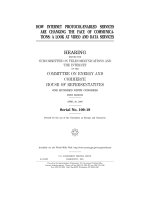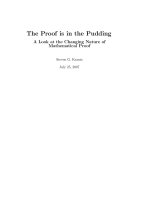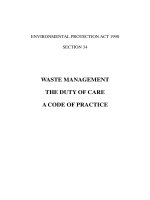Earnings management by real activities manipulations a look at vietnam
Bạn đang xem bản rút gọn của tài liệu. Xem và tải ngay bản đầy đủ của tài liệu tại đây (1.48 MB, 96 trang )
UNIVERSITY OF ECONOMICS
ERASMUS UNVERSITY ROTTERDAM
HO CHI MINH CITY
INSTITUTE OF SOCIAL STUDIES
VIETNAM
THE NETHERLANDS
VIETNAM – THE NETHERLANDS
PROGRAMME FOR M.A IN DEVELOPMENT ECONOMICS
EARNINGS MANAGEMENT BY REAL ACTIVITIES
MANIPULATION: A LOOK AT VIETNAM
BY
NGUYEN DUY ANH
MASTER OF ARTS IN DEVELOPMENT ECONOMICS
HO CHI MINH CITY, November 2016
UNIVERSITY OF ECONOMICS
INSTITUTE OF SOCIAL STUDIES
HO CHI MINH CITY
THE HAGUE
VIETNAM
THE NETHERLANDS
VIETNAM - NETHERLANDS
PROGRAMME FOR M.A IN DEVELOPMENT ECONOMICS
EARNINGS MANAGEMENT BY REAL ACTIVITIES
MANIPULATIONS: A LOOK AT VIETNAM
A thesis submitted in partial fulfilment of the requirements for the degree of
MASTER OF ARTS IN DEVELOPMENT ECONOMICS
By
NGUYEN DUY ANH
Academic Supervisor:
Vu Viet Quang
HO CHI MINH CITY, November 2016
DECLARATION
This is to certify that this thesis entitled “Earnings Management By Real Activities Manipulations:
A Look At VietNam”, which is submitted by me in fulfillment of the requirements for the degree
of Master of Art in Development Economics to Viet Nam – The Netherlands Programme (VNP).
To the best of my knowledge, my thesis does not infringe on anyone’s copyright nor violate any
proprietary rights and that any ideas, techniques, quotation, or any other material from the work
of other researchers in my thesis, published or otherwise, are fully acknowledge in accordance
with the standard referencing practices.
HCMC, November 30th, 2016
Nguyen Duy Anh
i
ACKNOWLEDGEMENT
I would like to thank my supervisor, Dr. Vu Viet Quang for his comprehensive guidance, great
support and valuable advice he has given through my research study. I have been very lucky to
a supervisor who took a high cared about my work and who respond to my question. He
consistently allowed this paper to be my work but steered me in the right the direction whenever
he thought I needed it. His careful editing contributed enormously to the production of this
thesis.
I also would like to thank my co-supervisor Dr. Truong Dang Thuy for his enthusiastic support,
availability and constructive suggestion, which help me overcome the challenge and highpressured situation during the time of research.
I would like to express my gratitude to all lecturers of the Vietnam- Netherlands Program who
have provided an interesting lesson to build my economic knowledge during this program.
Besides, completing this work would have been difficult if it is not supported by my best
friends. I am indebted to them for their help. Moreover, I wish to thank all my friends who are
in VNP 21 who share unforgettable memories in this program.
Finally, there are also words of deep gratitude for my family who support and encourage me
when I implement my postgraduate studies.
ii
ABSTRACT
This research thesis tests three hypothesizes: (i) In Viet Nam, the listed companies that meet
earnings target (zero earnings and zero earnings growth) exhibit the proof of real activities
manipulation (ii) Hypothesis 2: there is the difference between the extent of using real activities
manipulation of the listed firm that meet benchmark and those that meet earning benchmark
and have a high value of an asset (iii) there is no relationship between firm using real activities
manipulation to just meet earnings benchmark and future performance. Our tests were based
on data included 2374 firm-year observation covering 2005 to 2015.We focus on companies
that satisfy one of the criteria: zero earnings or zero earnings growth. The firms meet the criteria
call suspected firms or belong to suspected firms group. The rules identify the firms that more
likely to using real activities manipulation. We examine three types of real earnings
management: (1) cutting discretionary expenditures (2) acceleration of timing of sales (sale
manipulation) (3) reducing the cost of production. To measure real earnings management, we
follow the cross-section model developed by Roychowdhury (2006), Gunny (2010); and
estimate abnormal production cost, abnormal discretionary spending (sum of SG&A, R&D,
and advertising) and abnormal CFO. Our finding is that Vietnamese listed firmed apply real
activities management to meet earnings benchmark. Besides, the degree effect of cutting
production cost of the suspected firms with a high value of assets is highest (11.14%) among
three types of real activities management (2.54% for sale manipulation and 0.398% for
reducing discretionary expenses, which suggest the firm with a good reputation prefer employ
cutting production cost to meet companies target. Final, the companies which engage in CFO
manipulation or cutting discretionary expenses, as real earnings management to just meet
earnings benchmarks have no impact on subsequent performance. In contrast, the companies
which engage in production cost as real earnings management to just meet earnings
benchmarks have negative impact on subsequent performance.
Keyword: Capital markets; Accounting choice; Earnings manipulation.
iii
Table of Contents
DECLARATION .............................................................................................................................. i
ACKNOWLEDGEMENT ............................................................................................................... ii
ABSTRACT .................................................................................................................................... iii
CHAPTER 1 .................................................................................................................................... 1
INTRODUCTION ........................................................................................................................... 1
1.1.
Problem statement ................................................................................................................ 1
1.2.
Research objective ................................................................................................................ 3
1.3.
Research questions ............................................................................................................... 4
1.4.
Structure of study ................................................................................................................. 4
CHAPTER 2 .................................................................................................................................... 5
LITERATURE REVIEW ................................................................................................................ 5
2.1.
Key concept ...................................................................................................................... 5
2.1.1.
Definition of earnings management .......................................................................... 5
2.1.2.
Real activities management definition ...................................................................... 8
2.1.3.
Accruals .................................................................................................................... 8
2.2.
Models to detect the use of earnings management ........................................................... 9
2.2.1.
2.3.
Jones model ............................................................................................................... 9
Incentive to earnings management ................................................................................. 11
2.3.1.
Debt Covenants ....................................................................................................... 11
2.3.2.
Compensation.......................................................................................................... 12
2.3.3.
Insider Trading ........................................................................................................ 14
2.3.4.
Management buyout ................................................................................................ 14
2.4.
Beating benchmark (zero earnings) ................................................................................ 15
2.5.
Empirical research on real earnings management .......................................................... 19
2.5.1.
Type of real earnings manipulation ........................................................................ 21
2.5.2.
Impact of real activity management on firm future performance ........................... 23
2.6.
Hypotheses development ................................................................................................ 24
CHAPTER 3 .................................................................................................................................. 26
METHODOLOGY AND DATA DESCRIPTION ........................................................................ 26
iv
3.1.
Selection of suspect firm-year ........................................................................................ 26
3.2.
Real earnings proxies...................................................................................................... 26
3.3.
Empirical model.............................................................................................................. 28
3.3.1.
Empirical model to test hypothesis 1 ...................................................................... 28
3.3.2.
Empirical model to test hypothesis 2 ...................................................................... 29
3.3.3.
Empirical model to test hypothesis 3 ...................................................................... 30
3.3.
Data collection ................................................................................................................ 31
3.3.1.
Data collection ........................................................................................................ 31
3.3.2.
Variable descriptions............................................................................................... 32
CHAPTER 4 .................................................................................................................................. 35
RESULTS AND DICUSSION ...................................................................................................... 35
4.1.
Selected suspected firm-year .......................................................................................... 35
4.2.
Descriptive statistics ....................................................................................................... 36
4.3.
Testing the assumptions of panel data regression ........................................................... 40
4.3.1.
Multicollinearity...................................................................................................... 40
4.3.2.
Autocorrelation ....................................................................................................... 41
4.4.
Empirical and discussion ................................................................................................ 42
4.4.1.
Empirical evidence on the real activities manipulation of Companies listed in the
Viet Nam stock market ........................................................................................................... 42
4.6.2.
Discussion about real activities manipulation ......................................................... 45
4.6.3.
Size effect on real earnings management ................................................................ 49
4.6.4.
The accociation between using real activites managmet to meet earnings
benchmark and future performance ........................................................................................ 52
CHAPTER 5 .................................................................................................................................. 55
CONCLUSION, CONTRIBUTION, AND LIMITATION ........................................................... 55
5.1.
Main finding ................................................................................................................... 55
5.2.
Contribution .................................................................................................................... 57
5.3.
Limitation and further research ...................................................................................... 57
5.
Reference ................................................................................................................................ 59
6.
Appendix ................................................................................................................................ 63
v
List of Table and Figure
List of Tables
Table 1: Earnings management definition .............................................................................................. 8
Table 2: Calculating abnormal accruals ................................................................................................ 11
Table 3: Variable descriptions .............................................................................................................. 32
Table 4: Description statistics for sample firms in 2005-2015 period ................................................. 37
Table 5: Pearson Correlation matrix ..................................................................................................... 40
Table 6: Variance inflation factor ......................................................................................................... 41
Table 7: Comparison of suspect firm and the rest of sample ................................................................ 45
Table 8: Capture net effect when firms combine one more type of real earnings management ........... 49
Table 9: Multivariate regression analyses of size effect on earnings management in Vietnam listed
firms ...................................................................................................................................................... 50
Table: 10 Regression between real activities and future performance.................................................. 53
List of Figure
Figure 1: Framework for understanding the practice of Accounts Manipulation. ................................. 6
Figure 2: A hypothetical value function. .............................................................................................. 16
Figure 3: The losses have more impact on than an equivalent amount of gain. ................................... 17
Figure 4: The distribution of changes in net income divided by market value of equity at the beginning
of the year. ............................................................................................................................................ 18
Figure 5: histogram of distribution of net income scaled by lagged total assets (Figure 5A) and
histogram of distribution of change in net income scaled by lagged total assets (Figure 5B) .............. 35
Figure 6: Comparing mean of the suspect firm group (include observation of firm with zero earnings
and firm with zero earnings growth) and men of the rest of sample. ................................................... 39
vi
ABBREVIATION
RM
REM
Real management
Real earnings management
vii
CHAPTER 1
INTRODUCTION
1.1. Problem statement
With the explosion of the Dot-Com bubble in 2000, the previous stock which used to be bullish
now became going down. Then, in the end, the awful reality kept up with the firms which were
supposed to try to hide the unpleasant truth in their financial reports. The beginning of the long list
big scandal happened in 2000 when Xerox admitted that over a four year – period, their income had
been overstated by US$1. 4 billion. They boosted their income by reported revenue from the lease
of printers and copier in the long-term too early. Unfortunately, it was not an isolated example.
Enron Corporation uses a special purpose accounting entities which help them hide billion dollars
worth of debt away its balance sheet. WorldCom employed a simple scheme to change more than
US$ 11 billion of cost to assets. Tyco International executives were accused of covering million
US dollar debt, which they borrowed from employees with interest – free or very low-interest loans
and do not disclose these loans. After investigation of the U.S. Securities and Exchange
Commission, Quest Communication was forced to adjust their profit by US $2.4 billion because
Quest Communication reported impressive income from the transaction is booked as revenue
without receiving money. The series of financial accounting scandal still goes on. As a result of the
scandals, the collapse of cooperation lead to hundreds of billion dollars in loss for investors,
thousand job losses. The collapse of WorldCom in May 2002 is the biggest, with approximately
US $180 billion in the loss and also 30.000 lost jobs.
Besides financial accounting scandals, it also highlights the failures to audit financial statement
correctly. For example, Arthur Andersen LLP, which was one member of Big 5 accounting firm in
the world, prepared Enron’s financial report. Andersen also collapses after Enron scandal.
According to the Securities and Exchange Commission investigation, firstly, Andersen found out
many “trouble” transactions which were highly risky, but Andersen audit firm received a million
fees, so Andersen did not give their opinion of these risk. Further, Andersen ordered their
company’s Houston office destroy a thousand of the document to prevent Securities and Exchange
Commission from investigating Enron’s bankruptcy. These Arthur Andersen scandals reduce the
faith of investor in the integrity of the audit firm. After all, United States of America enacted
Sarbanes-Oxley Act in July 2002 to improve the business environment and protect investors.
1
The new environment force academics, regulator, and practitioners concern with companies
‘earnings management to protect investment and control capital market efficiency. There are two
reasons why we should study earnings management. Firstly, more research on earnings
management, more suggestion for improvement (Ronen, 2002a, 2002b, 2002c). The others try to
understand the earnings management phenomenon (Ronen and Yaari, 2007). According to
Erickson, Hanlon, and Maydew (2006), if we can understand clearly why earnings management
occur, and how it is created, we can effectively prevent futures happening. Accounting research
shows that not all earnings management is wrong. Therefore, each type of earnings management,
we can take an active action to avoid this risk.
Schipper (1989) defines: “Earnings management occurs when managers use judgment in financial
reporting and structuring transactions to alter financial reports to either mislead some stakeholders
about the underlying economic performance of the company or to influence contractual outcomes
that depend on reported accounting numbers.” In another word, somebody is acting something
which effects negatively on someone else. For example, to evaluate firm’s credibility; financial
health and viability; creditors apply the numbers reported (Ge, 2010). In turn, among other
indicators, investors use earnings to monitor operational performance. Nevertheless, their
conclusions on a given number reported could be incorrect if they are unable to recognize and adapt
to the impacts of earnings management which is hiding in the financial statements. This distortion
will become apparent in future results when the firm’s performance does not match their
evaluations.
Accruals manipulation does not involve by altering operating activities of the firm, but through
selecting the relevant accounting system to meet desired goals. On the other hand, real earning
management is the action of managers to reach their objective by changing real firm operations
such as decline research & development cost; decreasing selling, general and administrative
outlays; sales promotion. These two types of earnings management are tools for managers to
increase/decrease revenues; nevertheless, one form has an effect on real activities, and the other
form does not involve in operation.
There are some possible benefits if managers employ REM, even though the cost of using accruals
management could be lower than REM. Firstly, based on accruals management, every action on
changing financial reports is quickly placed under scrutiny by regulator and auditor, whereas both
auditor and regulator cannot prevent financial executives from employing REM. Secondly, the
flexibility of using accruals management is limited. For example, accruals management must occur
2
at the end of quarter or year, and the efficiency of accruals management is uncertainty, it depends
on the acceptableness of auditor.
The convincing proof on firms employs real earnings management is supported by Graham et al.
(2005) who conducted a survey 401 financial executives to find out core elements which affect
decisions involve in presenting income and voluntary disclosure. This paper demonstrates 78% of
the managers interviewed are willing to make from small to large sacrifices as long as they meet an
earnings target. In addition to, the decline in research and development (R&D), advertising and
maintenance cost are employed by 80 percent of participants, while more than a half of them would
delay a new project.
In finance and accounting, none of the research topics can be more provocative than earnings
management, to the point that a quantity of the investigation on detection and results of earnings
management is exponential growth. Although, accruals management and real earnings management
(REM) are two groups of earnings management (Healy & Wahlen, 1999), most of these current
studies do not take into earnings management by manipulating real activities. While in the recent
year, especially after the biggest accounting scandal of Enron and WorldCom, there has been
increasing attention to the identification of various types of real activities management. Besides
that, whether investors recognize the effects of this manipulation to protect their investment.
Although in the developed country, these issues got much attention, in Asia in general and Vietnam
in particular, there is little research on these topics. Therefore, the aim of this paper is to examine
whether the companies in Viet Nam employ real activities manipulation to meet the income target.
As far as we know, earnings management area has not studied in Viet Nam. Therefore, it is
necessary to research that thoroughly investigates the real earnings management in order to bring
an overview of earnings management. The results of this research can be applied in various fields
such as finance, company governance, studying… The sample is covered last update data in the
2005-2015 period. This study utilizes a cross-section estimation for industry-year to measure the
proxy of real earnings management and Feasible Generalized Least Squares estimation to estimate
the degree of using real earnings management in listed companies in Viet Nam.
1.2. Research objective
In overall, the purpose of this thesis research is threefold. First, this study examines the companies
apply real activities management as a plan for manipulation to meet the firm’s target. Then, the
second objective investigates whether on the well-known companies use real activities management
to report a good profit. Final, we examine the relationship between firm using real activities
3
manipulation just to meet earnings benchmark and future performance. Our tests were based on
data included 2374 firm-year observation covering 2005 to 2015.We focus on companies that
satisfy one of the criteria: zero earnings or zero earning growth. The firms meet the criteria call
suspected firms or belong to suspect firms group. The rules identify the firm that more likely to
using real activities manipulation. We examine three types of real earnings management: (1) cutting
discretionary expenditures (2) acceleration of timing of sales (sale manipulation) (3) reducing the
cost of production. To measure real earnings management, we follow the cross-section model
developed by Roychowdhury (2006) and Gunny (2010). Then, we will regress the equation with
two key variables: real earnings management variable (dependent variable) and suspected firms
variable (independent variable) and control variable to meet research object following.
1.3. Research questions
To meet the research object, the following research questions need to be answered:
The first question is: Do the Vietnamese listed companies employed real activities
manipulation to meet zero earnings or zero earnings growth?
Then, is there the difference between the extent of using real activities manipulation of the
listed firms that meet zero earnings or zero earnings growth benchmark, and those meet that
benchmark with a high value of an asset?
Finally, is there no relationship between firm using real activities manipulation to just meet
earnings benchmark and future performance?
1.4. Structure of study
The remainder of this study is organized as follows. Chapter 2 will present the fundamental concept
and discussion of earnings management as well reviews the literature on real activities
manipulation. Chapter 3 presents our empirical methodology, the method used for regressing, a
conceptual framework, and sample selection construction. Next, data collection and data
description are presented in the same chapter. Chapter 4 demonstrates and analyzes the empirical
results while the last chapter shows research’s conclusion and gives a suggestion for further
research.
4
CHAPTER 2
LITERATURE REVIEW
This chapter presents basic background information, and the literature review includes (theoretical
and empirical review) about real earnings management. The first section of this chapter provides
some fundamental concept in our area: earnings management, real earnings management, and
accruals. After that, we introduce Jones model which is a basic model together with the important
idea to explore earnings management in general. The reason why companies applied real earnings
management is presented in the next section. In the fourth section, we present beating benchmark
event which helps find out a firm that is more likely to apply earnings management. The final part,
it presents empirical research on real earnings management.
2.1.
Key concept
2.1.1. Definition of earnings management
Earnings management is one forms of accounts manipulation - other types remain big bath
accounting, creative accounting, window dressing, accounting income smoothing. Stolowy and
Breton (2004) defined accounts manipulation as managers use their judgment to build transactions
or make accountant system choices which have an impact on the probability of affluence move
between the firm and fund providers (cost of capital), society (political costs) or managers
(compensation plans). The diagram below presents the framework of studying earnings
management. And, it also shows where earnings management is.
5
Potent Interpretation
ACCOUNTS
MANIPULATION
Outside the limits of
Within the limits of laws
and standards
Potential Wealth Transfer
Return:
Earnings per share
(EPS)
Fraud
streams
streams
Main research
Earnings
management
real
earnings
management
accruals
management
Few
empirical
researches
Many
empirical
researches
Income
smoothing
Variance of
EPS
streams
Type of
research
Creative accounting
(window dressing)
Return:
Earnings per share (EPS)
Main research
Main research
Structural risk:
Debt/equity ratio
Many
empirical
researches
Interpretation
Big bath
accounting
Academic
perspective
Reduction of
current EPS
to increase
future EPS
Few real
empirical
researches
Professional
prespective
EPS
Debt/equity
ratio
Few real
empirical
researches
No
empirical
researches.
Professional
opinion
Transaction
Figure 1: Framework for understanding the practice of Accounts Manipulation. Adapted from
“Accounts manipulation: A literature review and proposed conceptual framework”, by, H. Stolowy
and, G. Breton, 2004. Review of Accounting and Finance, 3(1), 5-92
6
Healy and Wahlen (1999) are the first authors set standard setter shapers for earning management
definition: “Earning management occurs when managers use judgment in financial reporting and
structuring transaction to alter financial reports to either mislead some stakeholders about the
underlying economic performance of the company or to influence contractual outcome that depends
on reported accounting numbers”.
The goodness of this definition is that it covers the costly contracting approach (earnings
management is applied to affect contractual results) and informational approach (earnings
management is used to deceive stakeholders). Besides, it demonstrates administration as the party
responsible for employing those judgments involved the exercise of earnings management. The
connotation of definition also means opportunistic earnings management.
Nevertheless, this description has two weaknesses. First, not all earnings management lead to
misinterpretation. For instance, investors would like to distinguish earnings persistence from one
times shocks. The company, which manages earnings let investors readily recognize the elements
do not influence on earnings. Besides, this action increases the informational benefit of a company
announces earnings. Second, this definition does not create a distinct frontier between normal
operations whose production is earnings and earnings management. Dharan (2003) shows that it is
a complicated issue for people who use company’s financial report is how to separate clearly
between earnings manipulation which related to fraud and reasonable strategy of managers to meet
the firm’s target.
The table 1 below summarizes the key point of definition of earnings management, categorizing
them as beneficial, neutral, harmful. Beneficial earnings management improves report
transparency; while misrepresentation and fraud are related to the harmful entirely. The neutral is
the manipulation of the financial statement within the limits of conformity with obvious law rule
of standing. This could be either efficiency improvement or opportunistic.
7
Table 1: Earnings management definition
Beneficial
Earnings management is using
Neutral
Earnings management is a
Harmful
Earnings management is
the benefit of choosing freely
decision on accounting
directorate intervention to
in accounting regulation to
regulation which optimizes a
mislead or decline in the
transfer executive’s messenger
benefit of management only or
transparency of the financial
on future cash flows.
maximizing firm value.
statement.
Ronen and Sadan
(1981), Demski, Patell,
and Wolfson (1984),
Suh (1990), Demski
(1998), Beneish (2001),
Sankar and Subramanyam
(2001)
Fields, Lys, and Vincent
(2001), Scott (2003)
Schipper (1989), Levitt
(1998), Healy and
Wahlen (1999), Tzur
and Yaari (1999),
Chtourou, Bédard, and
Courteau (2001), Miller
and Bahnson (2002)
This study quotes the definition of earnings management of Ronen and Yaari (2008):
“Earnings management is a collection of managerial decisions that result in not reporting the true
short term, value-maximizing earnings as known to management. Earnings management can be:
Beneficial: it signals long-term value; Pernicious: it conceals short- or long-term value; Neutral: it
reveals the true short-term performance. The managed earnings result from taking action on
business activities before income are recognized, or making the decision on accounting choices that
affect the earnings numbers and their interpretation after the true earnings are realized.”
2.1.2. Real activities management definition
Roychowdhury (2006) defines real activities management as “Real activities manipulation, on the
other hand, entails departures from normal operational practices, motivated by a managers’ desire
to mislead at least some stakeholders into believing certain financial reporting goals have been met
in the normal course of operations.”
Gunny (2010), defines REM as: “… when managers undertake actions that change the timing or
structuring of an operation, investment and financing transaction in an effort to influence the output
of the accounting system.”
2.1.3. Accruals
2.1.3.1.
-
Definition of accruals
Accrual basis of accounting and cash basis of accounting
8
According to International Accounting Standards (IAS), under the accrual basis of accounting,
income and costs are recognized when they meet the recognized standard for those components in
the IAS, whether or not cash is received, cash is paid.
-
Accruals in earnings management
Accruals happen when the timing of accounting records of transactions and timing of cash flows is
different.
2.1.3.2.
Non-discretionary accruals and discretionary accruals
Identification between normal accruals and accruals caused managed earnings is the major issue
which researchers attempts to distinguish.
Ronen and Yaari (2008) definite that:
-
Non-discretionary accruals – so called normal accruals - are accruals which start from firm’s
activities happened at present that is usual for the company given firm’s strategy, performance
level and other factors (effect of the industry, macroeconomic…).
-
Discretionary accruals – also known as abnormal accruals - are accruals that begin by firm’s
activities created or accounting regulation selected to manage earnings.
2.2. Models to detect the use of earnings management
Study of Ronen and Sadan (1981), Healy (1985), DeAngelo (1986, 1988b), Dechow and Sloan
(1991) and Jones (1991) seems to be milestones in the study which try to measure abnormal
accruals. However, nowadays, the idea of the study of Jones (1991) – call Jones model- applies
widely in examining earnings management. Therefore, in this section, this study introduces a
method detect earnings management through abnormal accruals.
2.2.1. Jones model
Jones (1991)’s research question is that United States International Trade Commission (ITC) uses
import relief as a tool to protect domestic firms from imports who use dumping, countervailing duty
or any action affected local companies seriously. The ITC determines the injury using accounting
number sales levels; cash flow; decline in profit, production or raise unemployment… before
making import relief decisions. Most of cased, domestic firms increased their wealth. Therefore,
not only Jones but also the ITC member believes that manager has considerable incentive to make
an adjustment to a financial statement, whether they think the regulators are confused about making
a decision. Jones (1991) studies earnings management by the United States of America Firm in
Import Relief investigation by United States International Trade Commission (ITC). Jones
9
examined hypothesis: executives’ U.S companies, which gain the advantage of import protection,
intervene income statement which decline recorded profit at examination time compared to nonexamination time.
Jone model:
Jones’s assumption is before the event; companies do not exercise earnings management.
Therefore, the progress of the company’s earning can be divided into two sub-period, accruals
expectation stage, where abnormal accruals = 0, and the event period.
1. Expectation stage
In the expectation stage, the normal accruals are:
TA𝑖𝑡
𝐴𝑖𝑡−1
= 𝛽𝑖 𝐴
1
𝑖𝑡−1
+ 𝛽1𝑖
∆REV𝑖𝑡
𝐴𝑖𝑡−1
PPE𝑖𝑡
+ 𝛽2𝑖 𝐴
𝑖𝑡−1
+ 𝜀𝑖𝑡
Where:
TA𝑖𝑡 : total accruals in year t,
∆REV𝑖𝑡 : Revenue in year t subtract revenue in year t-1,
PPE𝑖𝑡 : gross plant, property and equipment in year t,
𝐴𝑖𝑡−1 : total assets in year t -1,
𝜀: error term,
𝑖: indicate to firm, i = 1,2,3…n.
The intercept does not include in this equation because of the inversion of the lagged assets. All
variables in Jones model are divided by lagged assets to overcome heteroscedasticity. Managers
use revenues as the benchmark to measure companies’ performance before they decide
manipulations. Besides, revenues are not totally exogenous. Therefore, they are included in the
equation to control the economic environment of the firm. While the ratio between total accruals
and normal accruals depreciation expense is controlled by Gross property, plant, and equipment
variable.
2. Stage 2:
̂
̂ ̂ ̂
After obtaining 𝛽̂𝑖 ,𝛽̂
1𝑖 , 𝛽2𝑖 of 𝛽𝑖 ,𝛽1𝑖 ,𝛽2𝑖 from the first stage, respectively, the parameters 𝛽𝑖 ,𝛽1𝑖 , 𝛽2𝑖
is put into the equation. The Jones model assumes that there is stationary in relation between normal
accruals and independent variables. The error term of the equation is abnormal accruals
(discretionary accruals).
10
Table 2: Calculating abnormal accruals
Normal accruals:
̂
TA
1
∆REV𝑖𝑡
PPE𝑖𝑡
𝑖𝑡
= 𝛽̂𝑖
+ 𝛽̂
+ 𝛽̂
1𝑖
2𝑖
𝐴𝑖𝑡−1
𝐴𝑖𝑡−1
𝐴𝑖𝑡−1
𝐴𝑖𝑡−1
Abnormal accruals
at time t
(discretionary
accruals)
̂
𝜇𝑖𝑡 = TA𝑖𝑡 − TA
𝑖𝑡
2.3. Incentive to earnings management
There are many factors that encourage executive manage earnings. However, debt covenants,
executive compensation contracts, insider trading and capital market transactions (equity offerings)
are four common elements.
2.3.1. Debt Covenants
Financial statements cover a primary source of information for creditors. Debtors can evaluate
company performance through this information to set up debt contract terms. Mulford and
Comiskey (2002) explained that debt covenants are designed as a condition in debt obligations in
order to supervise company performance. For example, a creditor could require a maintain a
specific value of an accounting ratio or investing and financing within the limits of some activities.
If the debt covenant is violated, the borrower might levy a heavy cost of debt as the creditor could
increase the rate of interest, requiring additional assets as collateral or require immediate
repayment. Therefore, Beneish (2001) believe that debt covenants may provide an incentive for
directors to adjust income either to avoid the limitation of accounting system based on constraints
in debt obligations or to reduce the cost of agreements violations. Healy and Palepu (1990) provide
evidence that if the cost of violating the constraints in debt agreement is heavy, the company can
circumvent the restrictions of a debt obligation by adjusting income through accounting decision.
Watts and Zimmerman, 1986 offered the debt covenant hypothesis which forecast the company
would make a decision on the choice of accounting systems to reduce the probability of debt
covenant violation. In particular, Beatty and Weber (2003) studied whether the provision of a
company’ debt agreement affects the firm’s accounting choices. Their results provided evidence
that the companies whose the debt agreement permit changes in accounting method have an impact
on contract calculations are more incentive to manage income-increasing compared to their noncovenant counterparts.
11
DeFond and Jiambalvo (1994) use time-series and cross-sectional model for analyzing abnormal to
exanimate whether the firms which are closer to debt covenant is more likely to increase income
by making accounting choice. The research applies time-series and cross-sectional model to
analysis abnormal accruals. One year before the violation, income and abnormal accruals increase
together. In the year of abuse, in spite of none of the detection of earnings management, these results
imply some firm in this study did not become successful in manipulation due to monitor of auditor
and debtor.
Dichev and Skinner (2002) collect a massive database of the loan agreement to exanimate debt
covenant hypothesis (firms have more motivations to make earnings reporting decisions that
decrease the probability that accounting-based constraint in their companies’ debt obligation would
be violated). The study indicates an exceptionally a few companies just under contract thresholds
and a huge quantity of companies just reach or beat agreement thresholds. These result provide that
management intervenes accounting choice to prevent debt covenant violations.
Bharath, Sunder, and Sunder (2008) study borrower accounting quality measured by company's
abnormal accruals influences on debt contracting. The data included 7334 private bank loans to
3,082 firms obtained from the DealScan database in the 1988–2001 period, this research points to
a U - shaped relationship between the cost of debt and accounting quality. They consider their
measure of accounting quality under accruals as an indicator of harmful earnings management,
which increases the risk for debtors. This study demonstrates that companies with higher abnormal
accruals deal with complicated issues such as shorter maturity, higher interest rate or greater
probability of collateral. The interest rate is 8 percent greater than mean interest rate in the sample,
about one-month shorter at maturity of loan and 7.7 percentage point increases in the likelihood of
giving collateral.
2.3.2. Compensation
The manager’s remuneration is the most apparent reason explaining why executives manipulate
earnings. In most of the business, the executive will be received a reward such as an increase in
salary, cash and stock bonuses, grants of stock option… if they meet targets (accounting returns,
sales revenue, net income…).
The former literature present a lot of the relationship between the reported earnings and structure
of executive compensation. Healy (1985) is an early paper connect CEO bonus plan and earnings
management. This study indicates that a CEO bonus program encourages managers choose
accounting treatment and affect accruals to maximize their bonus award. By using changes in
12
procedures and total accruals, this study finds that (i) in the first condition, if earning after using
earnings manipulation is not meet the lower bound of the bonus plan, the manager will pick the
minimum abnormal accruals option since even if he try to maximize earnings, reported income does
not reach the lower point and manager will not receive a bonus. This strategy allows the manager
to optimize their future bonus. (ii) In the second case, if earnings before manipulating in the lower
and upper area, the manager will increase earnings by raising accruals until earnings reach the upper
bound. The manager chooses maximum accruals because the bonus is constant when income goes
beyond the upper bound. However, the manager will maximize earnings if the bonus plan does not
have the upper bound. (iii) Therefore, in the final case, when earnings before abnormal exceeding
the upper bound, the manager is more like to choose income-decreasing accruals and reported
earnings at the upper point. By delaying income beyond the upper bound, the managers increase
their future bonus. Murphy (2000) compares bonus payments of companies with external
performance standard to those with the internal performance standard. The results indicate that
firms which adopt internal standard are more probable to manage earnings than firms using external
standard. More detail, companies with external performance standard depend largely on previous
year performance in planning performance standard for next year. Therefore, there are two scenes.
Firstly, when earnings does not meet the norm, the manager has more incentive to manipulate
earnings to meet targets. While the managers have more incentive to decline in their attempt when
the target standard is reached.
In recently, researchers are more focus on option and stock award, which are the major type of
bonus package. For example, Bergstresser and Philippon (2006) who show that the use of abnormal
accruals for managing earnings is more active at companies where the award of executives is nearly
connected to the value of option and stock. One of the manipulations methods is an exercise option
in the high-accruals period and sell a huge number of shares. These results are similar to Burns and
Kedia (2005)’s finding: comparison with other types of compensation, such as an increase in salary,
incentive payouts, equity… a stock option is powerful incentives for executes to earnings
restatement. Finally, because of the critical role of chief financial officer (CFO) in preparing a
financial statement, a CFO who awarded by equity should have a more powerful effect than those
of chief executive officers (CEO) in manipulating earnings. Jiang, Petroni and Wang (2010) show
that the effect of CFO equity incentive on the probability of hitting analyst prediction and the level
of accruals is stronger than those of the CEO.
13
2.3.3. Insider Trading
Insider trading is one interesting object in economics, accounting or law. By using nonpublic
information, insider trading increases the likelihood to manage earnings harmfully. Some of the
studies indicate apparently evidence of a relationship between insider trading and coming deception
or insolvency (Summers and Sweeney, 1998; Beneish, 1999a; Agrawal and Cooper, 2007). Bones
(1999a) finds that: the executive of companies with income overstatement which break GAAP are
more probable to sell their shares and to receive stock appreciation right during the time earnings
are overstated. Banish is based on previous papers to expand his hypotheses about insider trading
and earnings management incentives. This study proposes that manager's action like informed
traders, selling or buying before decline (increase) in stock price, and sees the benefit from trading
as compensation for supplying their individual information to investors. This research also explains
in detail about manager insider trading. The managers will use their information about income
overstatement to buy (sell) for their gain. By overstating income, managers provide market
participant optimistic company’s prospects or hide the deterioration of business performance. In
case supplying good signal about business performance, the manager can raise the value of their
equity. In another case, the manager will sell their shares with a limitation volume to avoid an
attention of the SEC.
However, insider trading does not always mean harm. Boyer, Ciccone, and Zhang (2004)
investigate whether earnings reporting is beneficial or pernicious earnings management. The paper
arranges company stock – year into quintiles based on abnormal accruals (the company with highest
quintiles stand for the largest income-increasing company with lowest quintiles stand for smallest
income-decreasing abnormal accruals). The results provide evidence correct with opportunism
hypothesis: Manager’s purchasing volume of enterprises with optimistic prospects (manipulate
earnings upward) is relatively higher than the other directors, while the manager’s selling volume
of the company with losses and optimistic market forecast (manipulation earnings downward) is
significantly smaller than the other managers.
2.3.4. Management buyout
A management buyout (MBO) is a form of business acquisition where the directors of a firm buy
the enterprise from the current owners or parent company. When management buyout exercises,
there is a decline in earnings management. This case brings the manager into a conflict: the
executive who buys the company prefers paying as low a price as possible, while stakeholder would
like to sell their equity at the best price. Therefore, the manager has more likely to reported
downward earnings before the buyout event. The empirical research either support this hypothesis
14
or at least not deny it. The evidence of Perry and Williams (1994) indicates that in the year before
a management buyout, there is a reduction in reported earnings in their data of 175 buyouts in 19811988. Estimation of Wu (1997) shows that on average, the expenses of trading are decreased about
50 million US dollars by earnings management. Marquardt and Wiedman (2004a) investigate 100
management buyout during 1995-99. Firstly, the paper measures total discretionary accruals which
are a proxy for earnings management. Then, the authors determine single accruals which might be
used by managers to meet their income target: accounts receivable, inventory, accounts payable,
accrued liabilities, depreciation, special items. Their finding reveals that companies apply income
downward (exhibited by unexpected accounts receivable accruals, UAR) before management
buyouts. Especially, positive UAR of the management buyout is 38%, while this is 45% for the
control group.
2.4. Beating benchmark (zero earnings)
Beating a benchmark has been identified as one of the events which companies is more likely to
accomplish earnings management to influence the market price. Accounting number will be useless
if not some benchmark being compared. Therefore, companies have reasons to manage earnings to
meet criterion such as zero earning.
The comprehensive survey of Graham et at. (2005) reveals income is commonly employed as an
important indicator to measure the level of business success. And it is one of the most aims which
managers concern. In particular, the earning per share (EPS) is considered as the proper index for
market participants. Since investors need simple indicator which easy to understand, sum up firm
performance and compare across companies, which reduce the cost of accessing the large number
of available financial information.
15
Figure 2: A hypothetical value function. Retrieved from />
Then, the question is why market participants rely on zero benchmarks. There are two explanations
why zero earnings is an important point. Firstly, Prospect theory which developed in the field of
psychology is suggested by Kahneman and Tversky (1979). From psychology approach, Prospect
theory supposes that decision maker feels gains or losses from the neutral reference point, rather
than from the absolute level of welfare. Moreover, the characteristics of the person’s value function
are usually convex for losses and commonly concave for gain (Figure 2). This catches the view that
losses make a more uncomfortable feeling compared to the level of pleasure given by an equivalent
gain (Figure 3). As a result, people obtain the highest benefit when welfare goes from a loss to a
gain relative to the point of reference. The investors used commonly three natural reference points
(a) zero earnings; (b) the predicted value of analyst and (c) earnings of the previous year. According
to these features, Koonce and Mercer (2005) stated that ceteris paribus, companies which announce
a series of small profit will be preferable than enterprises that reported volatile earnings (some huge
profit and some minor loss).
16









